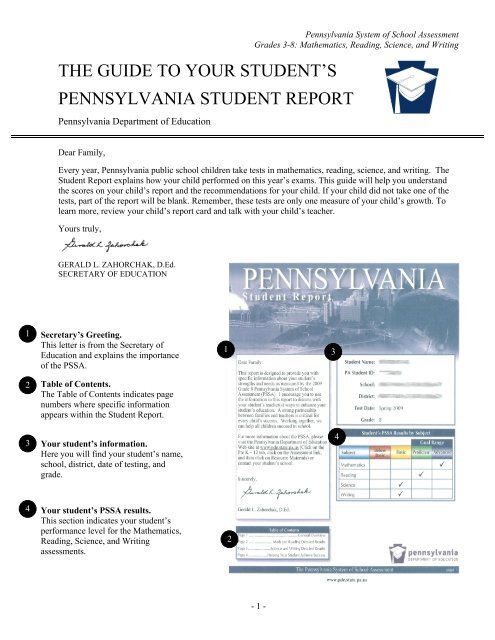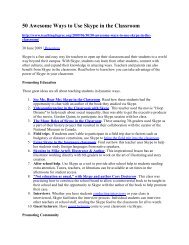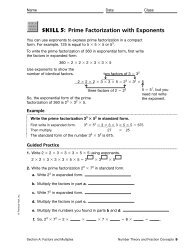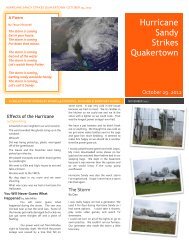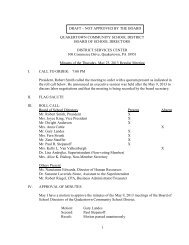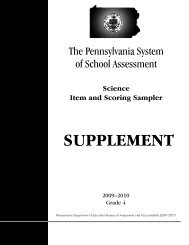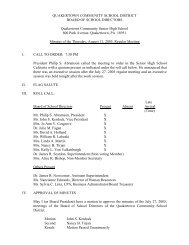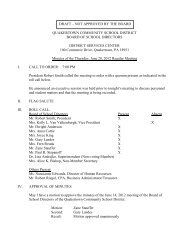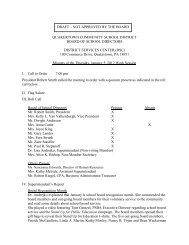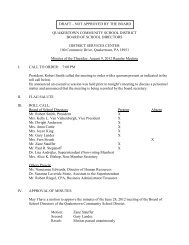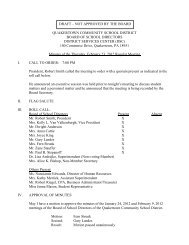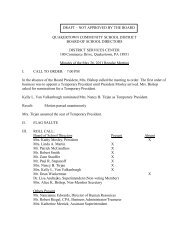Grades 3-8 Student Report Guide - English
Grades 3-8 Student Report Guide - English
Grades 3-8 Student Report Guide - English
Create successful ePaper yourself
Turn your PDF publications into a flip-book with our unique Google optimized e-Paper software.
THE GUIDE TO YOUR STUDENT’S<br />
PENNSYLVANIA STUDENT REPORT<br />
Pennsylvania Department of Education<br />
Pennsylvania System of School Assessment<br />
<strong>Grades</strong> 3-8: Mathematics, Reading, Science, and Writing<br />
Dear Family,<br />
Every year, Pennsylvania public school children take tests in mathematics, reading, science, and writing. The<br />
<strong>Student</strong> <strong>Report</strong> explains how your child performed on this year’s exams. This guide will help you understand<br />
the scores on your child’s report and the recommendations for your child. If your child did not take one of the<br />
tests, part of the report will be blank. Remember, these tests are only one measure of your child’s growth. To<br />
learn more, review your child’s report card and talk with your child’s teacher.<br />
Yours truly,<br />
GERALD L. ZAHORCHAK, D.Ed.<br />
SECRETARY OF EDUCATION<br />
1<br />
Secretary’s Greeting.<br />
This letter is from the Secretary of<br />
Education and explains the importance<br />
of the PSSA.<br />
1<br />
3<br />
2<br />
Table of Contents.<br />
The Table of Contents indicates page<br />
numbers where specific information<br />
appears within the <strong>Student</strong> <strong>Report</strong>.<br />
3<br />
Your student’s information.<br />
Here you will find your student’s name,<br />
school, district, date of testing, and<br />
grade.<br />
4<br />
4<br />
Your student’s PSSA results.<br />
This section indicates your student’s<br />
performance level for the Mathematics,<br />
Reading, Science, and Writing<br />
assessments.<br />
2<br />
- 1 -
Pennsylvania System of School Assessment<br />
<strong>Grades</strong> 3-8: Mathematics, Reading, Science, and Writing<br />
5<br />
What is your student’s Performance<br />
Level?<br />
This indicates your student’s<br />
Performance Level for the given subject.<br />
*Please Note: If your student was not<br />
tested because the subject is not<br />
applicable for the student’s grade, “Not<br />
Applicable (NA)” will be displayed. If<br />
your student did not receive a score,<br />
“No Score (NS)” will be displayed.<br />
5<br />
6<br />
6<br />
What is your student’s score?<br />
This indicates your student’s PSSA<br />
score for the given subject. Additionally,<br />
the arrow on the bar graph indicates<br />
where your student’s score falls within a<br />
performance level. The scores are<br />
organized by subject and appear on<br />
pages 2 and 3 of the <strong>Student</strong> <strong>Report</strong>.<br />
Because each subject has its own<br />
individual scale, student’s PSSA scores<br />
should not be compared across tested<br />
subjects.<br />
7<br />
7<br />
How did your student perform in<br />
each reporting category?<br />
This indicates the total points possible<br />
and your student’s performance within<br />
each reporting category.<br />
8<br />
8<br />
What do the Performance Levels<br />
mean?<br />
This section provides a general<br />
description of the Pennsylvania<br />
Performance Levels. <strong>Student</strong><br />
performance on the PSSA falls into four<br />
performance levels: Advanced,<br />
Proficient, Basic, and Below Basic.<br />
- 2 -
Pennsylvania System of School Assessment<br />
<strong>Grades</strong> 3-8: Mathematics, Reading, Science, and Writing<br />
9<br />
Standard Error of Measure.<br />
This range reflects the standard error of<br />
measurement (SEM) for your student’s<br />
PSSA score. Specifically, it provides<br />
reasonable bounds for the range of<br />
scores that your student might receive if<br />
he or she took an equivalent version of<br />
the test. (That is, your student took a test<br />
that covered exactly the same content,<br />
but included a different set of items.) As<br />
an example, if the PSSA score was 1750<br />
and the SEM band was 1700 to 1800,<br />
then your student would be likely to<br />
receive a score somewhere between<br />
1700 and 1800 if a different version of<br />
the test had been taken.<br />
9<br />
10<br />
10<br />
Strength Profile.<br />
The Strength Profile provides you with<br />
an indication of your student’s<br />
performance within each of the<br />
reporting categories. The profile<br />
measure takes into account the difficulty<br />
of the items and can be used to help<br />
identify areas in which your student<br />
needs to improve and where he or she<br />
has performed more successfully.<br />
11<br />
11<br />
Minimum/Maximum Scaled Scores.<br />
The minimum and maximum scaled<br />
scores represent the minimum and<br />
maximum scores your child could have<br />
received on each assessment. Each<br />
PSSA test has a minimum score that<br />
stays the same across years. However,<br />
the maximum score for each test can<br />
vary depending on the difficulty of the<br />
test each year (a more difficult test in<br />
any given year will have a higher<br />
maximum score).<br />
12<br />
12<br />
Resources for PSSA Information.<br />
This section lists additional resources<br />
for information about the PSSA.<br />
- 3 -
Pennsylvania System of School Assessment<br />
<strong>Grades</strong> 3-8: Mathematics, Reading, Science, and Writing<br />
13<br />
14<br />
Tips to help your student achieve<br />
success.<br />
This section suggests ways you can help<br />
your child achieve success, such as<br />
getting to know your child’s teachers or<br />
participating in school activities.<br />
Encouraging your student to read.<br />
This section suggests visiting your<br />
regional or neighborhood library. For<br />
more information about the benefits of<br />
reading<br />
to your child at home, please visit:<br />
www.statelibrary.state.pa.us.<br />
13<br />
15<br />
Connecting school work to activities<br />
outside the classroom.<br />
This section suggests ways you can help<br />
your child strengthen his or her overall<br />
education by engaging in enriching<br />
activities outside of the classroom.<br />
14<br />
16<br />
Understanding what your student<br />
should know.<br />
This section provides you with a resource<br />
to learn more about the Standards<br />
Aligned System and the Assessment<br />
Anchors. Pennsylvania standards<br />
describe what students should know and<br />
be able to do as they progress through<br />
school. The Assessment Anchors clarify<br />
the standards assessed on the PSSA and<br />
can be used by educators to help prepare<br />
their students for the PSSA. For more<br />
information please visit<br />
www.pde.state.pa.us/sas.<br />
15<br />
16<br />
- 4 -


